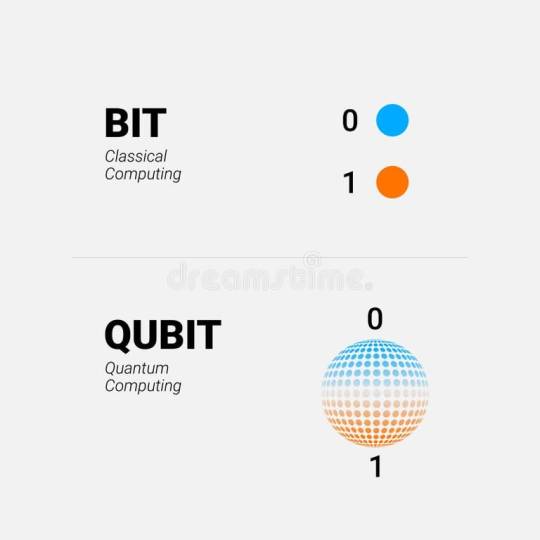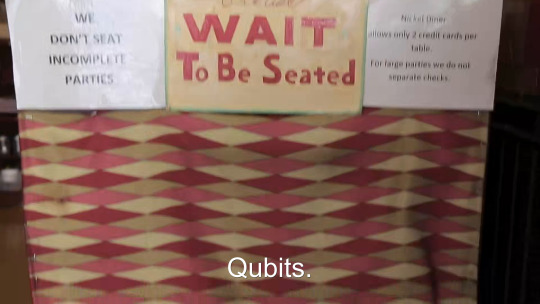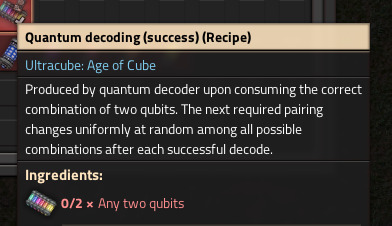#qubits
Explore tagged Tumblr posts
Text
Quantum Computing 101: What are Qubits?
Curious about quantum computing? Let's break it down!

🔍 What’s a Qubit? A qubit is the basic unit of quantum information. Unlike classical bits (0 or 1), qubits can be 0, 1, or both at the same time thanks to a phenomenon called superposition.
✨ Why Is This Cool?
Superposition: Allows qubits to explore many possibilities simultaneously.
Entanglement: Qubits can be linked, so the state of one affects the state of another, no matter the distance.
⚙️ In Action: This means quantum computers can tackle complex problems faster by processing a huge number of possibilities at once!
Follow for more insights on the future of tech! 🚀✨
Instagram: cs_learninghub YT: CS Learning Hub
#quantum computing#quantum#science#physics#computer science#bits#tumblr#aesthetic#studyblr#study#study motivation#qubits#machine learning#artificial intelligence#ai#ml#cs#learn#study blog
21 notes
·
View notes
Text
Reporting in the February 26 issue of the journal Nature, a team of scientists from AWS and Caltech demonstrate a new quantum chip architecture for suppressing errors using a type of qubit known as a cat qubit. Cat qubits were first proposed in 2001, and, since then, researchers have developed and refined them. Now, the AWS team has put together the first scalable cat qubit chip that can be used to efficiently reduce quantum errors. Called Ocelot, the new quantum computing chip is named after the spotted wild cat, while also giving a nod to internal "oscillator" technology that underlies the cat qubits.
5 notes
·
View notes
Text
Craig Gidney Quantum Leap: Reduced Qubits And More Reliable

A Google researcher reduces the quantum resources needed to hack RSA-2048.
Google Quantum AI researcher Craig Gidney discovered a way to factor 2048-bit RSA numbers, a key component of modern digital security, with far less quantum computer power. His latest research shows that fewer than one million noisy qubits could finish such a task in less than a week, compared to the former estimate of 20 million.
The Quantum Factoring Revolution by Craig Gidney
In 2019, Gidney and Martin Ekerå found that factoring a 2048-bit RSA integer would require a quantum computer with 20 million noisy qubits running for eight hours. The new method allows a runtime of less than a week and reduces qubit demand by 95%. This development is due to several major innovations:
To simplify modular arithmetic and reduce computing, approximate residue arithmetic uses Chevignard, Fouque, and Schrottenloher (2024) techniques.
Yoked Surface Codes: Gidney's 2023 research with Newman, Brooks, and Jones found that holding idle logical qubits maximises qubit utilisation.
Based on Craig Gidney, Shutty, and Jones (2024), this method minimises the resources needed for magic state distillation, a vital stage in quantum calculations.
These advancements improve Gidney's algorithm's efficiency without sacrificing accuracy, reducing Toffoli gate count by almost 100 times.
Cybersecurity Effects
Secure communications including private government conversations and internet banking use RSA-2048 encryption. The fact that quantum-resistant cryptography can be compromised with fewer quantum resources makes switching to such systems more essential.
There are no working quantum computers that can do this technique, but research predicts they may come soon. This possibility highlights the need for proactive cybersecurity infrastructure.
Expert Opinions
Quantum computing experts regard Craig Gidney's contribution as a turning point. We offer a method for factoring RSA-2048 with adjustable quantum resources to bridge theory and practice.
Experts advise not panicking immediately. Quantum technology is insufficient for such complex tasks, and engineering challenges remain. The report reminds cryptographers to speed up quantum-secure method development and adoption.
Improved Fault Tolerance
Craig Gidney's technique is innovative in its tolerance for faults and noise. This new approach can function with more realistic noise levels, unlike earlier models that required extremely low error rates, which quantum technology often cannot provide. This brings theoretical needs closer to what quantum processors could really achieve soon.
More Circuit Width and Depth
Gidney optimised quantum circuit width (qubits used simultaneously) and depth (quantum algorithm steps). The method balances hardware complexity and computing time, improving its scalability for future implementation.
Timeline for Security Transition
This discovery accelerates the inevitable transition to post-quantum cryptography (PQC) but does not threaten present encryption. Quantum computer-resistant PQC standards must be adopted by governments and organisations immediately.
Global Quantum Domination Competition
This development highlights the global quantum technological competition. The US, China, and EU, who invest heavily in quantum R&D, are under increased pressure to keep up with computing and cryptographic security.
In conclusion
Craig Gidney's invention challenges RSA-2048 encryption theory, advancing quantum computing. This study affects the cryptographic security landscape as the quantum era approaches and emphasises the need for quantum-resistant solutions immediately.
#CraigGidney#Cybersecurity#qubits#quantumsecurealgorithms#cryptographicsecurity#postquantumcryptography#technology#technews#technologynews#news#govindhtech
2 notes
·
View notes
Text

[Qubits.]
3 notes
·
View notes
Text
O poder da Computação Quântica
Saiba mais sobre computação quântica, os novos desafios e como isso pode alterar o nosso quotidiano, muito para lá da Inteligência Artificial.
Quando aprendi Informática, há quase quarenta anos, foi-me ensinado o que são bits, bytes, como funciona o código binário na computação e os princípios da álgebra de Boole, a lógica de verdadeiro ou falso. No fundo, tudo no raciocínio informático girava à volta do 0 (zero) e do 1 (um), o “If-then-else“. Volvidos uns anos (mais ou menos uns 30) passou-se a falar com mais insistência em…

View On WordPress
#Alan Turing#aprendizagem automática#Computação quantica#criptografia#deep fakes#pós-verdade#qubits#sobreposição#superposição#teste de turing#universos paralelos
1 note
·
View note
Text
El futuro es cuántico: ¿estamos listos?
En el horizonte de la innovación, una tecnología emerge con la promesa de transformar radicalmente el mundo tal y como lo conocemos. No se trata de una simple mejora de los ordenadores actuales, sino de un salto monumental hacia una nueva era. Hablamos de la tecnología cuántica, un campo que aprovecha las extrañas y maravillosas reglas de la física a escala atómica para resolver problemas que hoy…
0 notes
Text
Quantum Leaps: 5 Mind-Blowing Facts About Quantum Computing!
Quantum Leaps: 5 Mind-Blowing Facts About Quantum Computing! Quantum Leaps: 5 Mind-Blowing Facts About Quantum Computing! Hey there, tech enthusiasts and curious minds! Ever felt like you were living in a sci-fi movie, but couldn’t quite grasp the plot? Well, buckle up, because we’re about to dive headfirst into one of the most mind-bending, yet incredibly exciting, fields of modern technology:…
0 notes
Text
Quantum Physics vs Hansen's Models - interesting.
#Agent-Based (AI) Model#Data Scientists#entangled particles#metaprise#Quantum Mechanics#Quantum Physics#Qubits#strand commonality
0 notes
Text
And just like that, the hands of the clock sank into the darkest period of time's unwoven tapestry.
The rain. The blood. The pain. The lotus in the mud. The skin. The touch. Everything is unwrapping itself like it's too much.
The words. How do I explain the feeling behind having the need to express it all without expressing too much?
The people. The mediator. The secret of silently carrying the secret. The cage. The window. The depth of being hollow at the core. The design. The shadow knocking at the door.
Let me out.
Yes.
Please.
It's too heavy in here.
Hazy.
Dark.
Light.
Lightning.
Stupid circles.
Malicious tentacles.
Riddles.
Loopholes.
Stars.
It doesn't make any sense.
You are here now.
Time.
I missed you.
Entangled.
Quantum entanglement.
Revisit my state.
Reveal my fate.
But you missed my second hand.
I was just an ordinary bit.
Until I found you.
My Qubit.
1 note
·
View note
Text
The solution is to go into science to get access to a quantum computer that will do this thousands times over for you in the tiniest fraction of a second
But u know… I think your average laptop, that can run factorio, could also probably be made to solve a few hundred operations of this in a few seconds.
36 possible combinations really isn’t that much lol


there are 6 flavors of qubits (using the names from quarks, for some reason) and thus 36 possible configurations. So every time you have a successful decode, it randomizes, and you have to iterate through all the configurations again to find the correct one.
why would you do this to your players? do you hate them? do you want them to go mad building endless logic networks?
498 notes
·
View notes
Text
IBM anuncia progresso em computação quântica com chip livre de erros
A IBM divulgou nesta terça-feira, 10, grandes novidades sobre suas investigações em computação quântica, anunciando um caminho promissor para a criação de um computador quântico que seja livre de erros e capaz de resolver problemas reais nos próximos quatro anos. A companhia estima que em 2029 terá o processador Starling operando, com 200 qubits lógicos, o qual deverá ser capaz de realizar mais de 100 milhões de operações quânticas.(...)
Leia a noticia completa no link abaixo:
https://www.inspirednews.com.br/ibm-anuncia-progresso-em-computacao-quantica-com-chip-livre-de-erros

#ibm#computacaoquantica#processadorstarling#qubits#inovacao#ciencia#novayork#starling#algoritmosqldpc#poughkeepsie#engenharia#desafiostecnologicos#hardwarequantico
0 notes
Text
Top 10 Terms Every Quantum Computing Beginner Should Know
Quantum computing is one of the most revolutionary technologies of the 21st century, promising to solve complex problems that are beyond the reach of traditional computers. But for beginners, the terminology can be overwhelming. This blog post will break down the top 10 essential terms you need to know to get started with quantum computing, providing clear explanations, practical examples, and…
0 notes
Text
This spin control by spin-polarised currents at the quantum level opens up various possible applications. In contrast to electromagnetic fields, spin-polarised currents act very locally and can be steered with a precision of less than a nanometre. Such currents could be used to address electronic circuit elements in quantum devices very precisely and thus, for instance, control the quantum states of magnetic qubits.
1 note
·
View note
Text
Resource-Efficient Block Encoding Enables Quantum Algorithms

Block-encoding
Block-encoding operators are vital in quantum signal processing, and Fraunhofer IAO and Universität Stuttgart researchers found a resource-efficient way to construct them. This allows for larger, more sophisticated quantum algorithms and reduces the processing complexity of building them. The unique method assembles these fundamental quantum elements with almost optimal resource requirements for a wide range of input matrices, yielding a parameter count close to the number of free parameters. This crucial innovation enables optimisation for quantum systems with up to eight qubits.
Block-encoding is crucial to quantum signal processing (QSP) methods, which dominate quantum computer research. It allows quantum computers to mimic Hamiltonians in physics and quantum chemistry by representing non-unitary input matrices as sub-blocks of larger unitary operators.
Oracle query models and Linear Combinations of Unitarizes (LCU) can produce quantum advantages, but they often have drawbacks for near-term quantum computers, such as high ancilla overheads, a high number of multi-controlled gates, and unfavourable scaling with dense and unstructured matrices. Block-encoding operator gate complexity usually determines the quantum computing cost of the full quantum procedure.
To tackle these challenges, the group created Variational Block-Encoding (VBE). By encoding matrices with hardware-efficient parameterised quantum circuits (PQCs), VBE promises to improve quantum calculations on low-resource hardware.
Given that conventional methods require more than one ancilla qubit, this study's primary finding is that VBE can encode precisely with one. This matches theoretical bottom circuit parameter limits associated to the target matrix's degrees of freedom.
This study involves adapting the circuit architecture to the input matrix's intrinsic features, such as real or Hermitian values or symmetries. By directly integrating these symmetries into the circuit architecture, researchers can reduce encoding parameters and enhance efficiency. This parameter minimisation is crucial because it closely matches the quantum resources qubits and compute operations. Limiting circuits to real-valued or Hermitian targets reduces resource expenditures.
To build realistic quantum computers with fewer errors, the research explored the expressibility and complexity of quantum circuits, focussing on powerful circuits that can represent a matrix while being simple. Lie algebra and the Derivative Lie Algebra are used to analyse these circuits' generators to determine their capabilities and range of activities.
The generator basis set size determines the circuit's impressibility. The study found a correlation between the algebraic structure of circuit generators and the complexity of symmetry-restricted circuits, enabling more effective encoding schemes.
Numerical studies reveal that VBE efficiently encodes dense input matrices with the quantum circuit's free parameters closely matching the target matrix's lower bound of independent parameters. The smooth optimisation landscapes in VBE allowed classical optimisation methods like the BFGS optimiser to converge. The technique is very durable in the overparameterized setting, where any point can reach a global minimum.
VBE has significantly lower resource overhead than current block-encoding methods. In Heisenberg Hamiltonians, VBE reduces 2-qubit gate counts, a critical quantum resource metric, by more than an order of magnitude compared to LCU for systems up to five sites.
Systems with eight permutation-invariant circuit locations benefit from this. For larger systems, 2-qubit gate counts for LCU may seem smaller since the number of LCU terms increases polynomially, while VBE circuit sizes for most ansatzes save the permutation invariant one increase exponentially.
Despite these advances, VBE's fundamental limitation is the large amount of classical computation needed to tune variational parameters, which limits its application to systems with up to eight qubits. Optimisation landscapes and matrix calculations are exponentially more complex and expensive as systems grow.
The researchers suggest using VBE with LCU (linear combination of unitarizes) in the near future. VBE could encode smaller matrix blocks, and linear combinations could build the whole matrix, reducing resource needs.
Future research will examine multivariate quantum signal processing and how other system-specific factors can reduce circuit resource requirements. These investigations may yield circuit parameter determination methods without optimisation. The strategy also improves quantum machine learning and variational quantum eigensolvers.
#BlockEncoding#quantumalgorithms#qubits#quantumchemistry#Hamiltonians#quantummachinelearning#News#Technews#Technology#Technologynews#Technologytrends#Govindhtech
0 notes
Text
𝐓𝐡𝐢𝐬 𝐐𝐮𝐚𝐧𝐭𝐮𝐦 𝐂𝐡𝐢𝐩 𝐉𝐮𝐬𝐭 𝐁𝐫𝐨𝐤𝐞 𝐭𝐡𝐞 𝐑𝐮𝐥𝐞𝐬 𝐨𝐟 𝐂𝐨𝐦𝐩𝐮𝐭𝐢𝐧𝐠
Quantum chips are already outperforming supercomputers. From finance to AI, every industry is about to change. Are you ready for quantum disruption?
Watch https://youtube.com/shorts/bEd5MIcgOFY?feature=share
#QuantumComputing#DeepTech#QuantumAI#FutureOfTech#Qubits#YouTubeShorts#QuantumSupremacy#TechRevolution#AIHardware#fraoula
0 notes